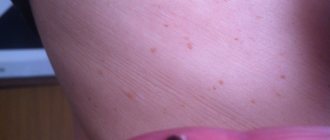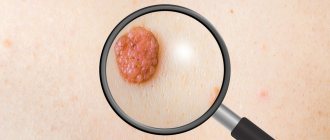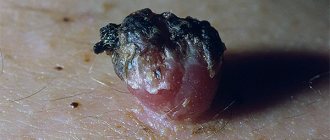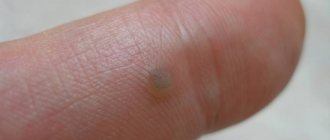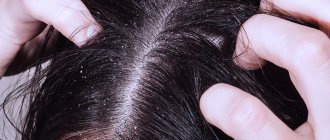Moles, birthmarks or nevi (medical term) are formations filled with pigment - melanin. They can be congenital or acquired. The first birthmarks begin to appear in children at six months of age. After 10 years, literally every person has them.
Moles are formed due to the accumulation of cells with pigment. When cells have too much melanin, they become melanocytes. The following reasons can be identified for their appearance:
- Heredity. The size and location of birthmarks are sometimes determined by genetics.
- Ultraviolet and solar radiation. Abuse of the sun and solarium leads to increased synthesis of melanin, which then forms nevi.
- Hormonal disorders. Fluctuations in hormonal levels caused by various diseases, pregnancy, etc. can lead to the formation of new birthmarks and the disappearance of existing ones.
- Radiation, x-ray exposure, trauma, virus. This causes an accumulation of cells with pigment.
In infants, moles are practically not observed, but they appear during the first year of life. Teenagers may experience a large number of birthmarks. This is due to hormonal changes during puberty. Completely unnoticeable spots can increase in size and change color, even turning black. For the same reason, during pregnancy, women, due to hormonal changes, form new moles, and old ones sometimes enlarge and become darker in color.
Birthmarks can form on all parts of the body, also on the mucous membranes and genitals.
Moles on breasts
Nevus is a congenital feature of skin development. On the surface of the skin, many cells containing the coloring substance melanin accumulate. Some formations do not contain melanin, but are also benign. They contain glomeruli of blood vessels and are called angiomas.
The main danger of birthmarks is the risk of degeneration into melanoma - skin cancer. If a mole appears on your chest, examine it carefully.
Signs of good quality:
- smooth borders;
- small size;
- uniform color;
- no change over time.
To track whether a stain is changing over time, take a photo of it and compare it periodically.
A large mole is not dangerous if it remains unchanged. A convex angioma is often injured, which accelerates its growth. If the spot thickens, itches, changes appearance, or bleeds, do not delay visiting the doctor.
A dermatologist (or oncologist) will take a section of tissue and send it for histological examination. The simplest method of taking material is a smear from the surface. Another method is to examine the formation on the patient's body with a dermatoscope. Its advantage is the absence of trauma. However, the device is not available in all clinics.
Doctors' opinion
A mole, or nevus, is a benign formation on the skin. Histologically, it is a cluster of melanocyte cells. Provoking factors for the development of nevi can be :
- action of ultraviolet radiation;
- hormonal changes (often observed during adolescence);
- diseases of internal organs;
- metabolic disorders;
- hereditary predisposition.
If a mole does not manifest itself in any way and does not cause concern, you can ignore it. However, if it begins to itch, hurt and quickly increase in size, this is a reason to consult a doctor. It is especially dangerous if the spot begins to grow in a child. Any such formation can be called benign only conditionally. Under the influence of unfavorable factors, it can degenerate into a malignant tumor - melanoma.
Only a doctor can determine the exact nature of the tumor based on histological examination of the tissue. Based on the test results, the specialist will recommend the most suitable treatment method. Under no circumstances should you try to remove a mole at home yourself.
The most effective methods of combating nevi are:
- Surgical is the most traumatic and is used extremely rarely.
- Laser.
- Cryodestruction - removal with liquid nitrogen.
- Radio wave - using the Surgitron apparatus.
If the birthmark is small in size and the treatment was carried out correctly, there will be no scars left on the body.
What formations need to be removed
The decision is made by the woman after visiting a dermatologist or oncologist. Excision must occur in a medical facility.
Traditional medicine methods are dangerous and can accelerate the growth of spots or lead to malignancy. First, a study of the material is carried out.
Nevi to be removed:
- Subject to constant injury, for example from a bra.
- Causing aesthetic discomfort.
- If degeneration is suspected.
Value depending on pattern
Particular attention is paid to moles that have the shape of a well-known figure. Sometimes there are quite complex outlines of objects. Interpretations of meanings may differ, so a person must make a choice himself and give preference to one of them:
- Zigzag. Difficult situations, unforeseen problems, absence of serious danger;
- Cross. An inevitable series of failures, a symbol of chosenness, a mission;
- Star. Patronage of fate, predisposition to occult sciences, spiritual development, success in money;
- Circle. Favorable sign, stormy temperament, tendency to depression;
- Triangle. Wealth, business success;
- Heart. Great love for life.
Two paired large moles promise a man great happiness in marriage. A black nevus warns of fateful decisions and significant events. Such men are prone to alcoholism and often do not have a permanent job.
Red moles usually appear suddenly on the body and indicate an intelligent person who should work in the field of scientific activity. A convex nevus speaks of a committed deed. If there are several of them, this is a sign of courage and bravery.
Removal method
After the decision to remove is made, a treatment method is selected. It will depend on the result obtained and the clinic’s equipment.
- The most accessible method is surgical removal with a scalpel. A large amount of tissue is affected. The operation is painful and local or general anesthesia is used. Rough scars remain. Therefore, the method is usually used for large formations.
- Cryodestruction is based on freezing a part of the body. Cooled liquid nitrogen or carbonic acid kills the cells of the spot to form a crust. Healthy young tissue grows underneath. The technique is less traumatic than using a scalpel. Does not leave scars and does not cause pain. But there is a risk of incomplete removal, after which the procedure has to be repeated. Cryodestruction is used to treat small flat spots.
- Electrocoagulation, on the contrary, is based on tissue cauterization. There is virtually no bleeding, the volume of excision is minimal. But the pain is higher, the affected tissue may also remain.
- Laser removal is used in beauty salons to remove small lesions. The radiation penetrates deeply, but does not leave defects on the surface of the skin. The patient does not feel pain. Disadvantage of the procedure: the likelihood of leaving part of the nevus. White spots often remain.
- Radiosurgical techniques have gained popularity in recent years. A special knife emits radiation that destroys the affected area and does not affect the healthy one.
When can I delete
If there are no medical indications for urgent excision, choose a good time for the procedure and follow the advice:
- If you are afraid of rough scars and stains, it is best not to remove them in the summer. Protect your body from ultraviolet radiation for about 2 months; if this is not possible, use products with SPF 50 protection.
- Do not visit the solarium.
- Address chronic illness issues early.
After a woman has removed a mole, she should not apply foreign agents to the gland. For the first day, avoid water treatments. You can cover the wound with a band-aid until a crust forms. Antibiotics are generally not required. Alcohol is not prohibited.
It is better to postpone surgery in the following cases:
- pregnancy;
- If you have a pacemaker, electrocoagulation cannot be used.
Scary pages from the history of the study of moles
In the Middle Ages, marks on the body were given special significance. The priests believed that any mole was a mark of evil spirits, which means that such people should be treated with suspicion. Large moles with a convex shape were especially feared. The worst thing is if such a “sign” was found on a woman’s body.
During the witch hunt, inquisitors even wrote a special treatise proposing to identify witches by looking at the skin of “three witches or Three witches to scan” any person.
The inquisitors were especially afraid of women with a mole of an even, round shape located on the inside of the knee, just above the bend. In the Middle Ages, this mark was called moon-shaped, and it was the most compelling evidence of a connection with evil spirits. Moleosophy confirms that such a mole indicates serious paranormal abilities of its owner. A woman with these abilities has a close connection with the world of the dead, can receive information from them and ask for favors. Deceased relatives always care about the well-being and success of a woman with a moon-shaped mole; they are her guardians.
A mole above the upper lip indicates the ability to hypnosis. Such a woman can damage and bless with just one word; she has a huge gift of persuasion. Men are especially susceptible to her charms; they simply cannot resist her magnetic charm and charisma.
I would like to add that only large moles that are clearly visible on the body are important. The appearance or disappearance of such a sign promises big changes in a woman’s life.
Prevention of nevi
A person who has many moles is at the same risk of melanoma as everyone else. However, they can cause significant discomfort and aesthetic problems.
To avoid an increase in the number and size of formations, as well as their malignancy, try to adhere to the rules:
- stay in the sun as little as possible;
- apply products with an SPF factor of 50 or higher (protects from the sun);
- avoid skin trauma;
- do not visit solariums;
- wear comfortable clothes made from natural materials;
- control blood hormones;
- undergo regular medical examinations.
Mark under the chest on the right
A mole under the right breast means that such a girl is persistent and assertive.
Her career comes first and she often achieves success in this area. In everyday life, such girls are wonderful mothers and spouses, but in work matters they are capable of going over their heads for the sake of career growth. This quality helps to achieve special success and become financially independent. In matters of competition, such people are unprincipled; they are ready to do anything for the sake of prestige, honor and the highest position. But in everyday life they become wonderful wives and mothers, as they know how to separate personal issues from work issues.
What does a mole on the chest mean?
Superstitions attach great importance to moles on women's chests. In the old days, spots on the chest were considered an ominous sign. They were said to influence the character and future of a person.
Now this interpretation is outdated. Such feminine zest is attractive to some men.
What a mole on the chest means depends on its location:
- A mole on the left breast is found in kind and meek girls who have loved one man all their lives.
- A mole on the right breast is a sign of falling in love.
- Nevi on the celiac plexus promise a calm, stable fate. The income of their owners is average. Ladies are relaxed in communication. And the birthmark acts as a talisman.
- The spot under the gland symbolizes a boring, measured life. The mole on the right happens to women who like to lash out at others, careerists. On the left are intriguers in matters of the heart.
- The location on the halo on the right is found in girls with an unfortunate fate. On the left - may indicate heart problems, but there is no medical confirmation of this.
- A formation on the nipple occurs in special people. In a woman, the appearance of a nevus on the mammary gland means that she is ready to become a mother and predicts a new addition to the family. By the way, it is recommended to remove the mole if a woman plans to breastfeed. Education on the right promises wealth, on the left - failure in love.
- A nevus on a man's chest testifies to his triumphs and defeats. He is an optimist and easily finds a solution to any issue. For those who have a mole located under the left nipple, professions related to travel and relocation are preferred. The location under the chest on the right symbolizes love and bright feelings. These guys are monogamous and remain faithful to their beloved all their lives. They are kind and sincere. If it is on the right nipple, the owner will experience family well-being and harmony in love relationships.
Conclusion
Whether to listen to these signs or not is a personal matter for everyone. They can impart sexuality or, conversely, become a reason for female complexes.
The main thing is to eliminate the risk of a malignant tumor and promptly notice adverse changes. Self-medication not only will not help, but it is also dangerous if you delay seeing a doctor and receiving treatment.
What symptoms should you see a doctor for?
Treatment will not be needed if the nevus is not cancerous. If the spot becomes dark, milky or red in color and begins to grow, there is a possibility that cell mutation has begun. It is important to monitor education during pregnancy. It is dangerous if the spots are hanging in nature and begin to darken.
After childbirth, the nipple spot will be constantly exposed and damaged during breastfeeding.
Signs of nevus degeneration into melanoma:
- increase in size;
- change in shape, color;
- the appearance of signs of inflammation: itching and pain.
Signs warn of a dangerous condition. An urgent visit to a doctor who will conduct an examination is required. If the diagnosis is confirmed, surgery is performed to remove the nevus.
Abnormal noncancerous moles
There is a special group of pigmented skin formations that are very similar in symptoms to melanoma, but still not cancerous. These are dysplastic nevi. They are more prone to malignant transformation, but this happens extremely rarely.
There are also cases of transformation of an ordinary birthmark into an atypical one. Therefore, it is advisable to consider the condition under which the mole began to grow . First you need to distinguish a dangerous formation from a dysplastic nevus. It is characterized by the following features:
- The size ranges from 6 mm to 12 mm in diameter.
- The presence of more than one shade of brown or black, sometimes including pink and bluish colors.
- The surface is rough and heterogeneous.
- The boundaries of the formation are unclear, disappearing into the surrounding skin.
- The ability to develop even after 35 years.
It is extremely difficult to determine on your own which particular nevus is prone to malignant degeneration, so it is better to seek advice from a dermatologist.
Important to know: Malignant moles: photo and description
Melanoma is a threat to life
This tumor grows in the skin, developing from special cells called melanocytes. It is the amount of pigment produced by these cells that will determine what color a person’s skin, eyes and hair will be. But when DNA abnormalities make cell division unregulated, a malignant tumor develops at the site of the mole.
Scary statistics
This is not the only malignant neoplasm that can appear on the skin: melanoma is diagnosed in only four out of a hundred patients with skin cancer. Nevertheless, this disease is the most dangerous in its category: death occurs in 72% of cases . If treatment is not carried out, the person dies one and a half to two years after the tumor begins to grow.
Among the reasons that can provoke malignant degeneration of nevus cells, the first place is the influence of ultraviolet radiation, especially its long waves. This factor is noted in 86% of cases, all other types of injury or exposure to chemicals account for only 14%.
That is why doctors advise not to overuse sunbathing. But the biggest danger lies in solariums, since they emit a lot of long UVA rays. Namely, they easily penetrate deep into the skin and cause defects in the DNA of melanocytes - and no visible damage is detected.
Swimsuits and T-shirts, especially wet ones, do not protect against long UVA rays. Therefore, even moles covered with fabric can be damaged.
As a result of excessive irradiation, a special MC1R protein can also become damaged. And it is necessary for the production of melanin and is indispensable for the restoration of DNA in cells.
Burns on exposed areas of the body, which occur after prolonged exposure to the scorching rays of the sun, appear after excessive exposure to other, short UVB rays. This factor can cause the development of skin cancer.
The consequences of the negative impact on melanocytes do not disappear anywhere! Each subsequent tan to the point of burn makes its contribution - subsequently quantity develops into quality and turns the body’s native cell into a mutant, which is able to reproduce uncontrollably. The process is further complicated by the emergence of new tumors of various locations as a result of metastasis.
It has been noted that melanoma develops 75% more often in young (under 35 years old) fans of artificial tanning. Often a tumor can appear where there used to be a harmless mole.
The incidence rate is high, despite explanatory work. So far, doctors have not been able to overcome the fashion for tanning “like a chocolate bar.” Over the past ten years in the Russian Federation, the number of detected melanomas has increased by 38%.
At-risk groups
Doctors warn that even five ultraviolet skin burns that have ever been suffered are enough to trigger the processes of melanocyte degeneration. Therefore, lovers of intense tanning under the scorching sun are at serious risk. They have a very high chance of getting melanoma. But if these people are also blond with blue eyes and very fair skin, the danger becomes even more real.
The hereditary factor cannot be ignored. If any of your relatives (parents, sisters or brothers) had melanoma, it is time for the person to take control of the situation and begin to especially closely monitor their moles.
To receive the minimum dose of ultraviolet radiation required for normal functioning of the body, it is enough to stay in the sun for only 20 minutes a day.
For men who sometimes, during their daily hygiene routine, are unable to carefully cut off all the hairs next to a mole, it is wiser to switch to using electric razors. Repeated cuts can provoke the degeneration of a nevus. By the way, in representatives of the stronger sex, melanoma is diagnosed more often and occurs in a more severe form.
The same danger can arise when a mole is constantly injured by clothing: rubbing or squeezing. Increased attention should be paid to the correct choice of belts and bras.
The risk of defects in DNA molecules in old age increases due to the accumulation of negative consequences after exposure to certain factors:
- ultraviolet radiation;
- ionizing radiation;
- smoking;
- individual medications, etc.
Even repeated exposure to household chemicals, such as highly acidic products, can also cause mutations in melanocytes. The risk will be minimized if work is carried out with rubber gloves.
Doctors noted that moles often grow on the body in people with excess body weight, as well as in those who actively absorb animal fats and proteins, but devote very little space in their diet to vegetables and fruits, especially fresh ones.
There are conditions that are benign for some time, but under the influence of aggressive factors they can change dramatically. Dubreuil's disease and xeroderma pigmentosum can be considered as precancerous skin diseases.


